Corporate Reputation Management: NTB Structure, Culture, and Strategy
VerifiedAdded on 2020/11/23
|43
|11613
|77
Report
AI Summary
This report provides a comprehensive analysis of managing corporate reputation, focusing on Nations Trust Bank (NTB). It begins by defining corporate identity, its relationship to reputation, and the importance of managing reputation. The report then critically analyzes NTB's corporate strategy, structure, and culture, examining its strengths and weaknesses. It delves into employee relations, exploring employee engagement strategies, and the importance of internal communications in strengthening corporate reputation. The analysis includes proposed changes to structure and culture, along with financial and political consequences. The report also assesses NTB's communication strategies, employee relations, and recommends improvements for enhancing corporate reputation. Appendices provide additional information including company background, financial performance, competitor analysis, and stakeholder attributes.
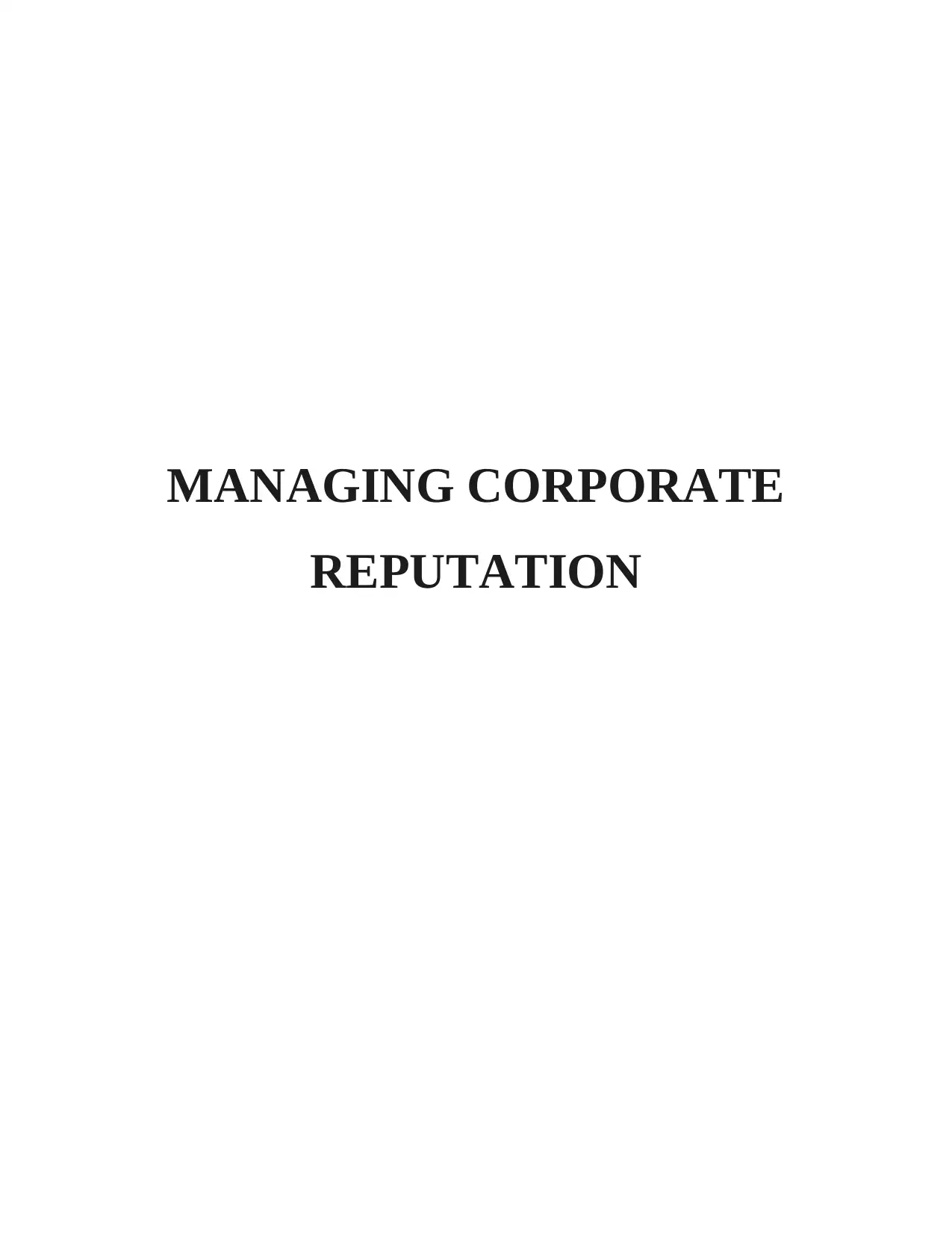
MANAGING CORPORATE
REPUTATION
REPUTATION
Paraphrase This Document
Need a fresh take? Get an instant paraphrase of this document with our AI Paraphraser
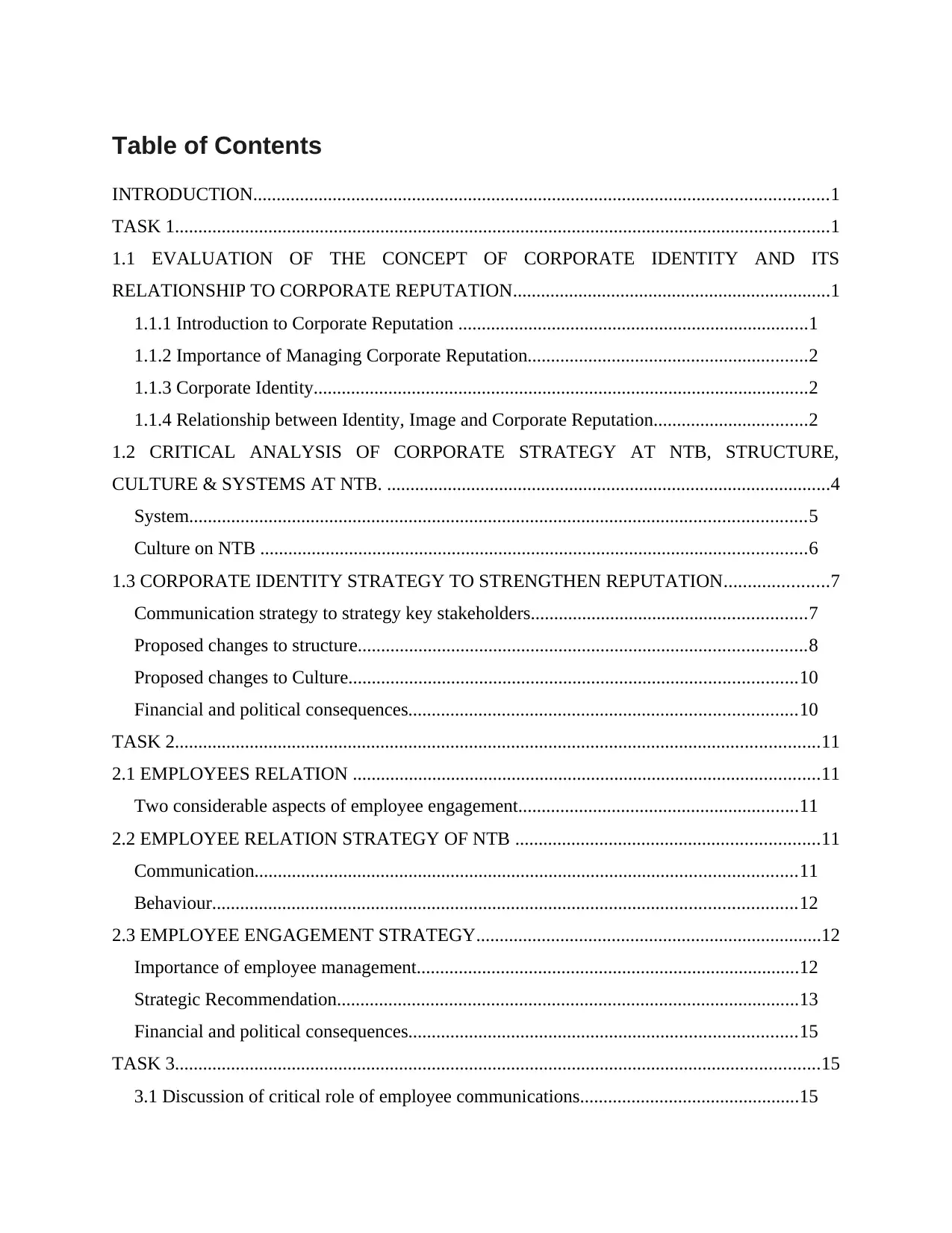
Table of Contents
INTRODUCTION...........................................................................................................................1
TASK 1............................................................................................................................................1
1.1 EVALUATION OF THE CONCEPT OF CORPORATE IDENTITY AND ITS
RELATIONSHIP TO CORPORATE REPUTATION....................................................................1
1.1.1 Introduction to Corporate Reputation ...........................................................................1
1.1.2 Importance of Managing Corporate Reputation............................................................2
1.1.3 Corporate Identity..........................................................................................................2
1.1.4 Relationship between Identity, Image and Corporate Reputation.................................2
1.2 CRITICAL ANALYSIS OF CORPORATE STRATEGY AT NTB, STRUCTURE,
CULTURE & SYSTEMS AT NTB. ...............................................................................................4
System....................................................................................................................................5
Culture on NTB .....................................................................................................................6
1.3 CORPORATE IDENTITY STRATEGY TO STRENGTHEN REPUTATION......................7
Communication strategy to strategy key stakeholders...........................................................7
Proposed changes to structure................................................................................................8
Proposed changes to Culture................................................................................................10
Financial and political consequences...................................................................................10
TASK 2..........................................................................................................................................11
2.1 EMPLOYEES RELATION ....................................................................................................11
Two considerable aspects of employee engagement............................................................11
2.2 EMPLOYEE RELATION STRATEGY OF NTB .................................................................11
Communication....................................................................................................................11
Behaviour.............................................................................................................................12
2.3 EMPLOYEE ENGAGEMENT STRATEGY..........................................................................12
Importance of employee management..................................................................................12
Strategic Recommendation...................................................................................................13
Financial and political consequences...................................................................................15
TASK 3..........................................................................................................................................15
3.1 Discussion of critical role of employee communications...............................................15
INTRODUCTION...........................................................................................................................1
TASK 1............................................................................................................................................1
1.1 EVALUATION OF THE CONCEPT OF CORPORATE IDENTITY AND ITS
RELATIONSHIP TO CORPORATE REPUTATION....................................................................1
1.1.1 Introduction to Corporate Reputation ...........................................................................1
1.1.2 Importance of Managing Corporate Reputation............................................................2
1.1.3 Corporate Identity..........................................................................................................2
1.1.4 Relationship between Identity, Image and Corporate Reputation.................................2
1.2 CRITICAL ANALYSIS OF CORPORATE STRATEGY AT NTB, STRUCTURE,
CULTURE & SYSTEMS AT NTB. ...............................................................................................4
System....................................................................................................................................5
Culture on NTB .....................................................................................................................6
1.3 CORPORATE IDENTITY STRATEGY TO STRENGTHEN REPUTATION......................7
Communication strategy to strategy key stakeholders...........................................................7
Proposed changes to structure................................................................................................8
Proposed changes to Culture................................................................................................10
Financial and political consequences...................................................................................10
TASK 2..........................................................................................................................................11
2.1 EMPLOYEES RELATION ....................................................................................................11
Two considerable aspects of employee engagement............................................................11
2.2 EMPLOYEE RELATION STRATEGY OF NTB .................................................................11
Communication....................................................................................................................11
Behaviour.............................................................................................................................12
2.3 EMPLOYEE ENGAGEMENT STRATEGY..........................................................................12
Importance of employee management..................................................................................12
Strategic Recommendation...................................................................................................13
Financial and political consequences...................................................................................15
TASK 3..........................................................................................................................................15
3.1 Discussion of critical role of employee communications...............................................15
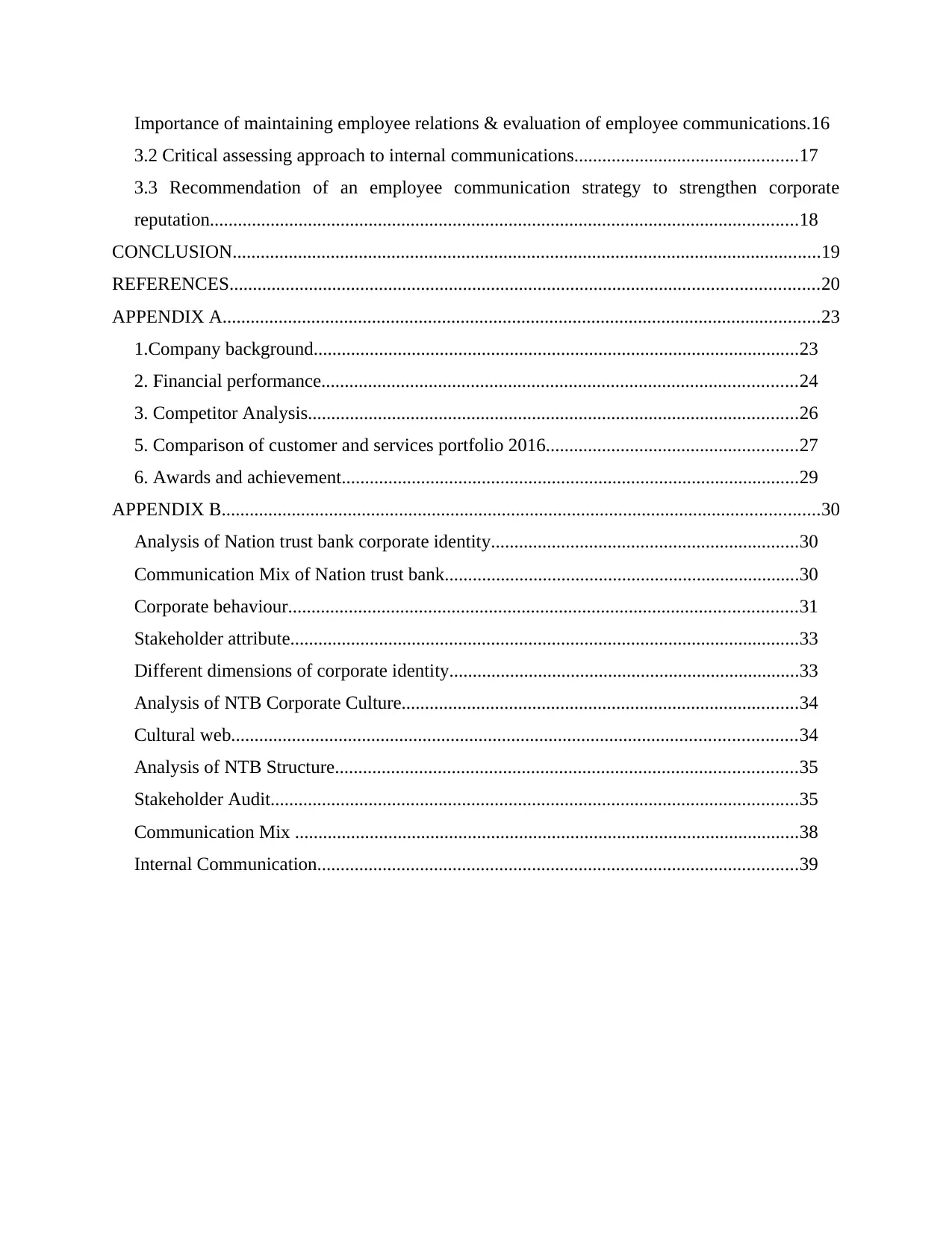
Importance of maintaining employee relations & evaluation of employee communications.16
3.2 Critical assessing approach to internal communications................................................17
3.3 Recommendation of an employee communication strategy to strengthen corporate
reputation..............................................................................................................................18
CONCLUSION..............................................................................................................................19
REFERENCES..............................................................................................................................20
APPENDIX A................................................................................................................................23
1.Company background........................................................................................................23
2. Financial performance......................................................................................................24
3. Competitor Analysis.........................................................................................................26
5. Comparison of customer and services portfolio 2016......................................................27
6. Awards and achievement..................................................................................................29
APPENDIX B................................................................................................................................30
Analysis of Nation trust bank corporate identity..................................................................30
Communication Mix of Nation trust bank............................................................................30
Corporate behaviour.............................................................................................................31
Stakeholder attribute.............................................................................................................33
Different dimensions of corporate identity...........................................................................33
Analysis of NTB Corporate Culture.....................................................................................34
Cultural web.........................................................................................................................34
Analysis of NTB Structure...................................................................................................35
Stakeholder Audit.................................................................................................................35
Communication Mix ............................................................................................................38
Internal Communication.......................................................................................................39
3.2 Critical assessing approach to internal communications................................................17
3.3 Recommendation of an employee communication strategy to strengthen corporate
reputation..............................................................................................................................18
CONCLUSION..............................................................................................................................19
REFERENCES..............................................................................................................................20
APPENDIX A................................................................................................................................23
1.Company background........................................................................................................23
2. Financial performance......................................................................................................24
3. Competitor Analysis.........................................................................................................26
5. Comparison of customer and services portfolio 2016......................................................27
6. Awards and achievement..................................................................................................29
APPENDIX B................................................................................................................................30
Analysis of Nation trust bank corporate identity..................................................................30
Communication Mix of Nation trust bank............................................................................30
Corporate behaviour.............................................................................................................31
Stakeholder attribute.............................................................................................................33
Different dimensions of corporate identity...........................................................................33
Analysis of NTB Corporate Culture.....................................................................................34
Cultural web.........................................................................................................................34
Analysis of NTB Structure...................................................................................................35
Stakeholder Audit.................................................................................................................35
Communication Mix ............................................................................................................38
Internal Communication.......................................................................................................39
⊘ This is a preview!⊘
Do you want full access?
Subscribe today to unlock all pages.

Trusted by 1+ million students worldwide
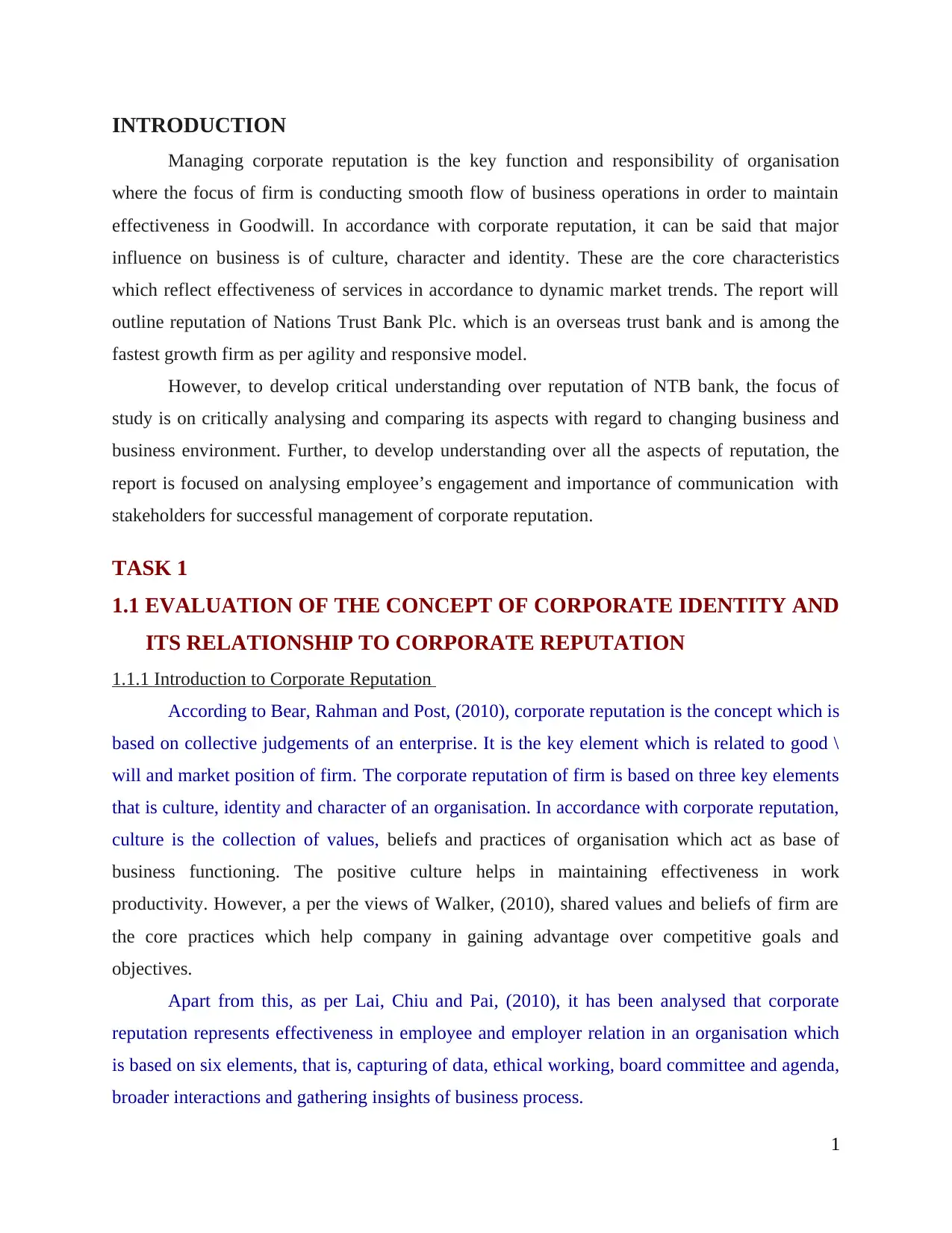
INTRODUCTION
Managing corporate reputation is the key function and responsibility of organisation
where the focus of firm is conducting smooth flow of business operations in order to maintain
effectiveness in Goodwill. In accordance with corporate reputation, it can be said that major
influence on business is of culture, character and identity. These are the core characteristics
which reflect effectiveness of services in accordance to dynamic market trends. The report will
outline reputation of Nations Trust Bank Plc. which is an overseas trust bank and is among the
fastest growth firm as per agility and responsive model.
However, to develop critical understanding over reputation of NTB bank, the focus of
study is on critically analysing and comparing its aspects with regard to changing business and
business environment. Further, to develop understanding over all the aspects of reputation, the
report is focused on analysing employee’s engagement and importance of communication with
stakeholders for successful management of corporate reputation.
TASK 1
1.1 EVALUATION OF THE CONCEPT OF CORPORATE IDENTITY AND
ITS RELATIONSHIP TO CORPORATE REPUTATION
1.1.1 Introduction to Corporate Reputation
According to Bear, Rahman and Post, (2010), corporate reputation is the concept which is
based on collective judgements of an enterprise. It is the key element which is related to good \
will and market position of firm. The corporate reputation of firm is based on three key elements
that is culture, identity and character of an organisation. In accordance with corporate reputation,
culture is the collection of values, beliefs and practices of organisation which act as base of
business functioning. The positive culture helps in maintaining effectiveness in work
productivity. However, a per the views of Walker, (2010), shared values and beliefs of firm are
the core practices which help company in gaining advantage over competitive goals and
objectives.
Apart from this, as per Lai, Chiu and Pai, (2010), it has been analysed that corporate
reputation represents effectiveness in employee and employer relation in an organisation which
is based on six elements, that is, capturing of data, ethical working, board committee and agenda,
broader interactions and gathering insights of business process.
1
Managing corporate reputation is the key function and responsibility of organisation
where the focus of firm is conducting smooth flow of business operations in order to maintain
effectiveness in Goodwill. In accordance with corporate reputation, it can be said that major
influence on business is of culture, character and identity. These are the core characteristics
which reflect effectiveness of services in accordance to dynamic market trends. The report will
outline reputation of Nations Trust Bank Plc. which is an overseas trust bank and is among the
fastest growth firm as per agility and responsive model.
However, to develop critical understanding over reputation of NTB bank, the focus of
study is on critically analysing and comparing its aspects with regard to changing business and
business environment. Further, to develop understanding over all the aspects of reputation, the
report is focused on analysing employee’s engagement and importance of communication with
stakeholders for successful management of corporate reputation.
TASK 1
1.1 EVALUATION OF THE CONCEPT OF CORPORATE IDENTITY AND
ITS RELATIONSHIP TO CORPORATE REPUTATION
1.1.1 Introduction to Corporate Reputation
According to Bear, Rahman and Post, (2010), corporate reputation is the concept which is
based on collective judgements of an enterprise. It is the key element which is related to good \
will and market position of firm. The corporate reputation of firm is based on three key elements
that is culture, identity and character of an organisation. In accordance with corporate reputation,
culture is the collection of values, beliefs and practices of organisation which act as base of
business functioning. The positive culture helps in maintaining effectiveness in work
productivity. However, a per the views of Walker, (2010), shared values and beliefs of firm are
the core practices which help company in gaining advantage over competitive goals and
objectives.
Apart from this, as per Lai, Chiu and Pai, (2010), it has been analysed that corporate
reputation represents effectiveness in employee and employer relation in an organisation which
is based on six elements, that is, capturing of data, ethical working, board committee and agenda,
broader interactions and gathering insights of business process.
1
Paraphrase This Document
Need a fresh take? Get an instant paraphrase of this document with our AI Paraphraser
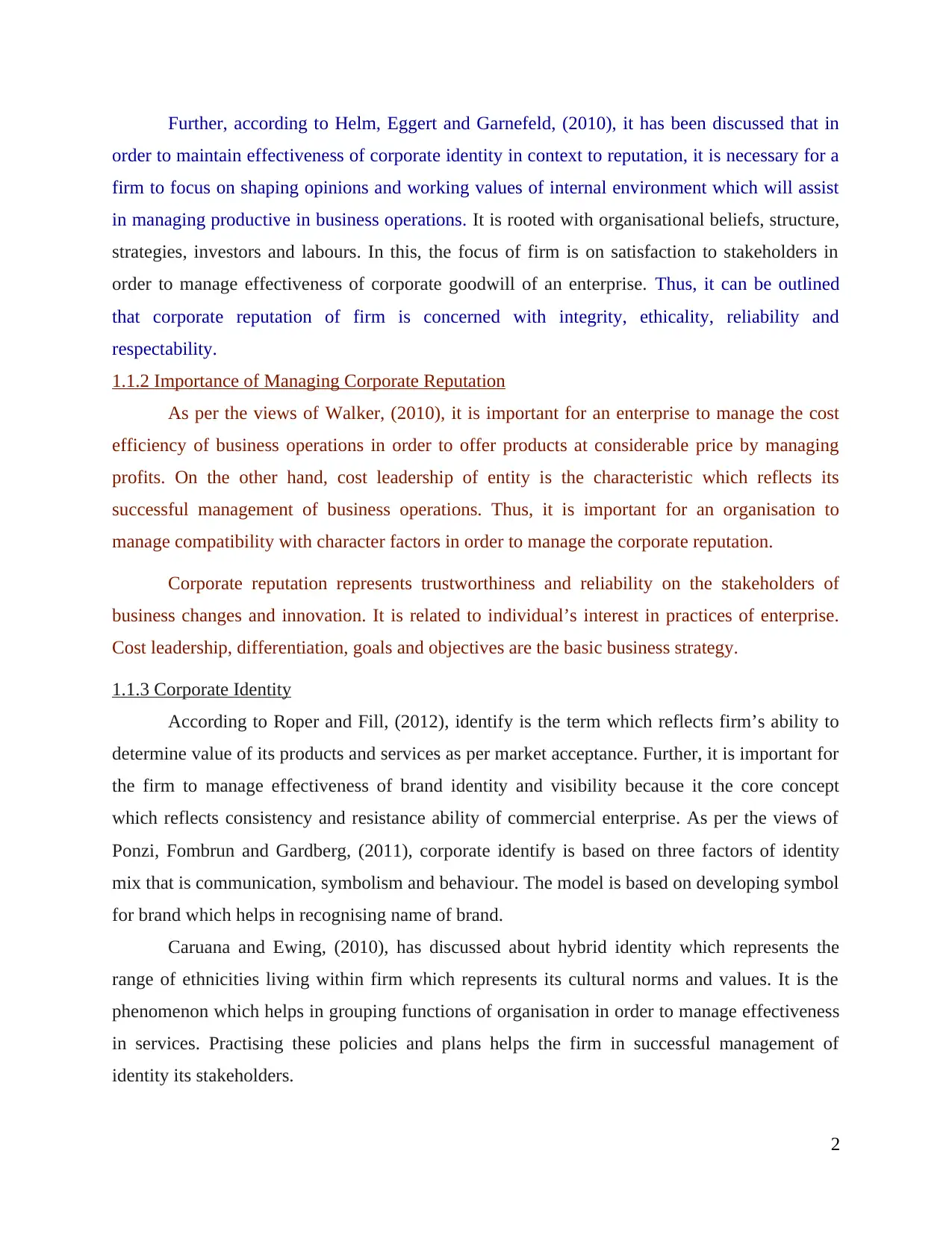
Further, according to Helm, Eggert and Garnefeld, (2010), it has been discussed that in
order to maintain effectiveness of corporate identity in context to reputation, it is necessary for a
firm to focus on shaping opinions and working values of internal environment which will assist
in managing productive in business operations. It is rooted with organisational beliefs, structure,
strategies, investors and labours. In this, the focus of firm is on satisfaction to stakeholders in
order to manage effectiveness of corporate goodwill of an enterprise. Thus, it can be outlined
that corporate reputation of firm is concerned with integrity, ethicality, reliability and
respectability.
1.1.2 Importance of Managing Corporate Reputation
As per the views of Walker, (2010), it is important for an enterprise to manage the cost
efficiency of business operations in order to offer products at considerable price by managing
profits. On the other hand, cost leadership of entity is the characteristic which reflects its
successful management of business operations. Thus, it is important for an organisation to
manage compatibility with character factors in order to manage the corporate reputation.
Corporate reputation represents trustworthiness and reliability on the stakeholders of
business changes and innovation. It is related to individual’s interest in practices of enterprise.
Cost leadership, differentiation, goals and objectives are the basic business strategy.
1.1.3 Corporate Identity
According to Roper and Fill, (2012), identify is the term which reflects firm’s ability to
determine value of its products and services as per market acceptance. Further, it is important for
the firm to manage effectiveness of brand identity and visibility because it the core concept
which reflects consistency and resistance ability of commercial enterprise. As per the views of
Ponzi, Fombrun and Gardberg, (2011), corporate identify is based on three factors of identity
mix that is communication, symbolism and behaviour. The model is based on developing symbol
for brand which helps in recognising name of brand.
Caruana and Ewing, (2010), has discussed about hybrid identity which represents the
range of ethnicities living within firm which represents its cultural norms and values. It is the
phenomenon which helps in grouping functions of organisation in order to manage effectiveness
in services. Practising these policies and plans helps the firm in successful management of
identity its stakeholders.
2
order to maintain effectiveness of corporate identity in context to reputation, it is necessary for a
firm to focus on shaping opinions and working values of internal environment which will assist
in managing productive in business operations. It is rooted with organisational beliefs, structure,
strategies, investors and labours. In this, the focus of firm is on satisfaction to stakeholders in
order to manage effectiveness of corporate goodwill of an enterprise. Thus, it can be outlined
that corporate reputation of firm is concerned with integrity, ethicality, reliability and
respectability.
1.1.2 Importance of Managing Corporate Reputation
As per the views of Walker, (2010), it is important for an enterprise to manage the cost
efficiency of business operations in order to offer products at considerable price by managing
profits. On the other hand, cost leadership of entity is the characteristic which reflects its
successful management of business operations. Thus, it is important for an organisation to
manage compatibility with character factors in order to manage the corporate reputation.
Corporate reputation represents trustworthiness and reliability on the stakeholders of
business changes and innovation. It is related to individual’s interest in practices of enterprise.
Cost leadership, differentiation, goals and objectives are the basic business strategy.
1.1.3 Corporate Identity
According to Roper and Fill, (2012), identify is the term which reflects firm’s ability to
determine value of its products and services as per market acceptance. Further, it is important for
the firm to manage effectiveness of brand identity and visibility because it the core concept
which reflects consistency and resistance ability of commercial enterprise. As per the views of
Ponzi, Fombrun and Gardberg, (2011), corporate identify is based on three factors of identity
mix that is communication, symbolism and behaviour. The model is based on developing symbol
for brand which helps in recognising name of brand.
Caruana and Ewing, (2010), has discussed about hybrid identity which represents the
range of ethnicities living within firm which represents its cultural norms and values. It is the
phenomenon which helps in grouping functions of organisation in order to manage effectiveness
in services. Practising these policies and plans helps the firm in successful management of
identity its stakeholders.
2
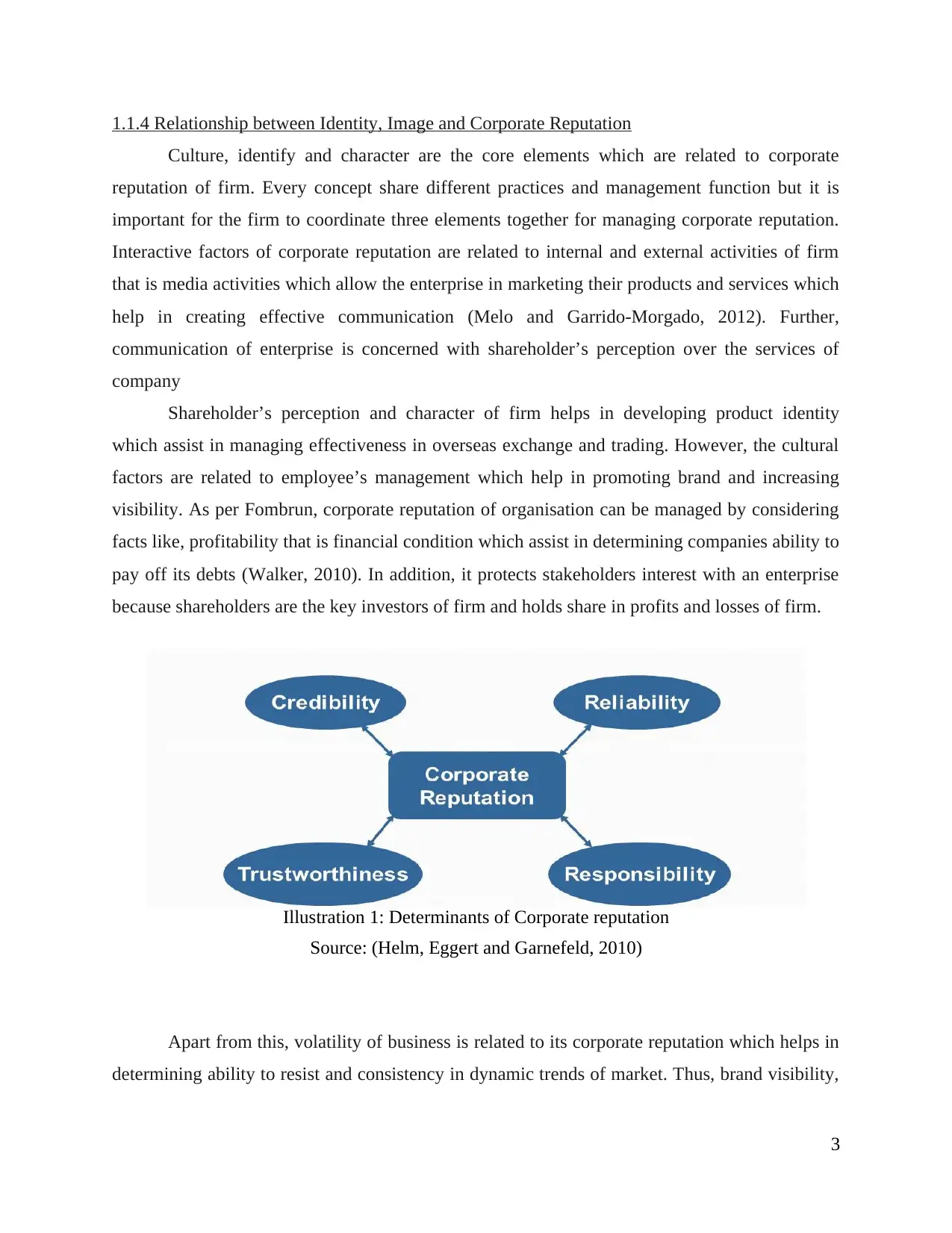
1.1.4 Relationship between Identity, Image and Corporate Reputation
Culture, identify and character are the core elements which are related to corporate
reputation of firm. Every concept share different practices and management function but it is
important for the firm to coordinate three elements together for managing corporate reputation.
Interactive factors of corporate reputation are related to internal and external activities of firm
that is media activities which allow the enterprise in marketing their products and services which
help in creating effective communication (Melo and Garrido‐Morgado, 2012). Further,
communication of enterprise is concerned with shareholder’s perception over the services of
company
Shareholder’s perception and character of firm helps in developing product identity
which assist in managing effectiveness in overseas exchange and trading. However, the cultural
factors are related to employee’s management which help in promoting brand and increasing
visibility. As per Fombrun, corporate reputation of organisation can be managed by considering
facts like, profitability that is financial condition which assist in determining companies ability to
pay off its debts (Walker, 2010). In addition, it protects stakeholders interest with an enterprise
because shareholders are the key investors of firm and holds share in profits and losses of firm.
Apart from this, volatility of business is related to its corporate reputation which helps in
determining ability to resist and consistency in dynamic trends of market. Thus, brand visibility,
3
Illustration 2: Determinants of Corporate reputation
Illustration 1: Determinants of Corporate reputation
Source: (Helm, Eggert and Garnefeld, 2010)
Culture, identify and character are the core elements which are related to corporate
reputation of firm. Every concept share different practices and management function but it is
important for the firm to coordinate three elements together for managing corporate reputation.
Interactive factors of corporate reputation are related to internal and external activities of firm
that is media activities which allow the enterprise in marketing their products and services which
help in creating effective communication (Melo and Garrido‐Morgado, 2012). Further,
communication of enterprise is concerned with shareholder’s perception over the services of
company
Shareholder’s perception and character of firm helps in developing product identity
which assist in managing effectiveness in overseas exchange and trading. However, the cultural
factors are related to employee’s management which help in promoting brand and increasing
visibility. As per Fombrun, corporate reputation of organisation can be managed by considering
facts like, profitability that is financial condition which assist in determining companies ability to
pay off its debts (Walker, 2010). In addition, it protects stakeholders interest with an enterprise
because shareholders are the key investors of firm and holds share in profits and losses of firm.
Apart from this, volatility of business is related to its corporate reputation which helps in
determining ability to resist and consistency in dynamic trends of market. Thus, brand visibility,
3
Illustration 2: Determinants of Corporate reputation
Illustration 1: Determinants of Corporate reputation
Source: (Helm, Eggert and Garnefeld, 2010)
⊘ This is a preview!⊘
Do you want full access?
Subscribe today to unlock all pages.

Trusted by 1+ million students worldwide
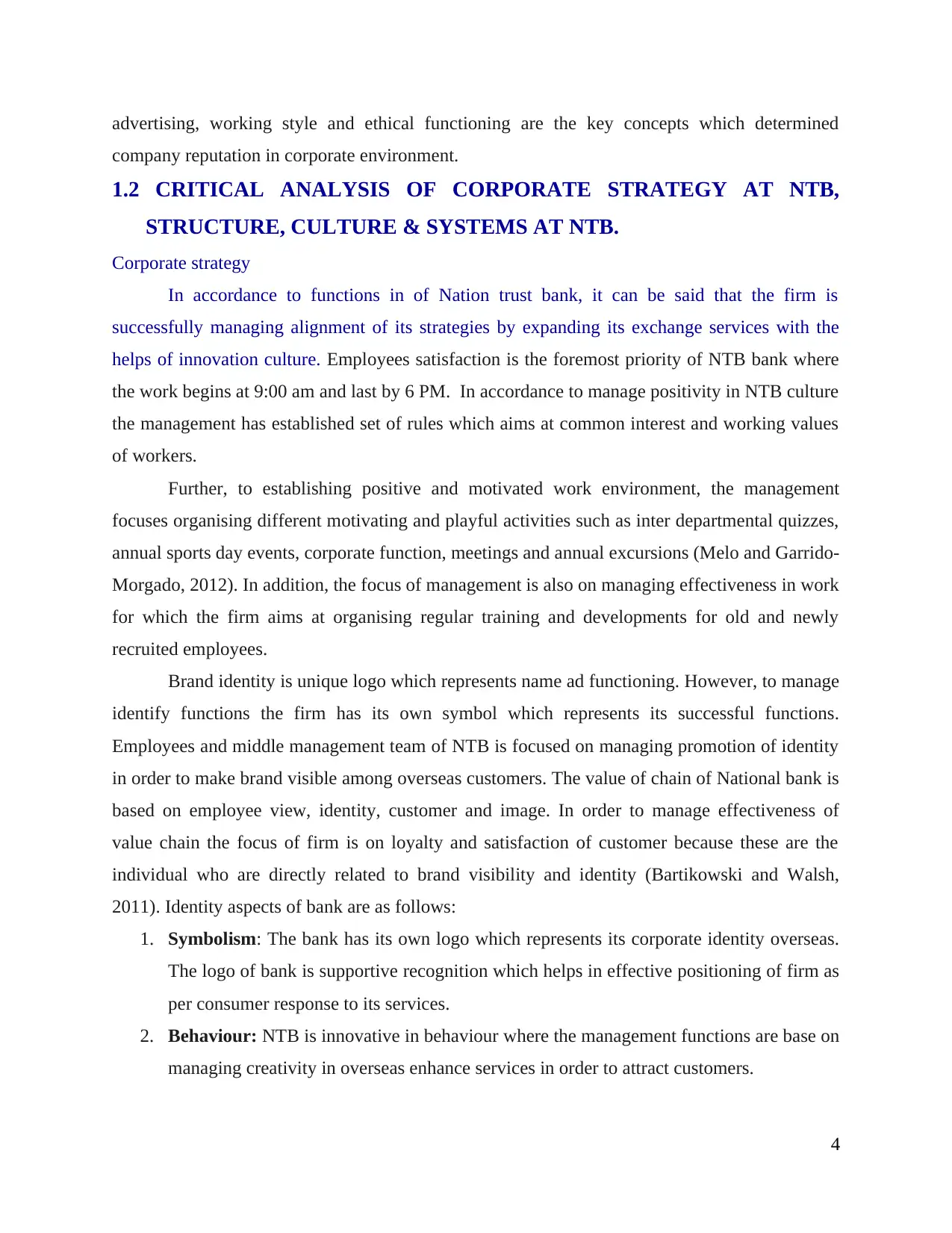
advertising, working style and ethical functioning are the key concepts which determined
company reputation in corporate environment.
1.2 CRITICAL ANALYSIS OF CORPORATE STRATEGY AT NTB,
STRUCTURE, CULTURE & SYSTEMS AT NTB.
Corporate strategy
In accordance to functions in of Nation trust bank, it can be said that the firm is
successfully managing alignment of its strategies by expanding its exchange services with the
helps of innovation culture. Employees satisfaction is the foremost priority of NTB bank where
the work begins at 9:00 am and last by 6 PM. In accordance to manage positivity in NTB culture
the management has established set of rules which aims at common interest and working values
of workers.
Further, to establishing positive and motivated work environment, the management
focuses organising different motivating and playful activities such as inter departmental quizzes,
annual sports day events, corporate function, meetings and annual excursions (Melo and Garrido‐
Morgado, 2012). In addition, the focus of management is also on managing effectiveness in work
for which the firm aims at organising regular training and developments for old and newly
recruited employees.
Brand identity is unique logo which represents name ad functioning. However, to manage
identify functions the firm has its own symbol which represents its successful functions.
Employees and middle management team of NTB is focused on managing promotion of identity
in order to make brand visible among overseas customers. The value of chain of National bank is
based on employee view, identity, customer and image. In order to manage effectiveness of
value chain the focus of firm is on loyalty and satisfaction of customer because these are the
individual who are directly related to brand visibility and identity (Bartikowski and Walsh,
2011). Identity aspects of bank are as follows:
1. Symbolism: The bank has its own logo which represents its corporate identity overseas.
The logo of bank is supportive recognition which helps in effective positioning of firm as
per consumer response to its services.
2. Behaviour: NTB is innovative in behaviour where the management functions are base on
managing creativity in overseas enhance services in order to attract customers.
4
company reputation in corporate environment.
1.2 CRITICAL ANALYSIS OF CORPORATE STRATEGY AT NTB,
STRUCTURE, CULTURE & SYSTEMS AT NTB.
Corporate strategy
In accordance to functions in of Nation trust bank, it can be said that the firm is
successfully managing alignment of its strategies by expanding its exchange services with the
helps of innovation culture. Employees satisfaction is the foremost priority of NTB bank where
the work begins at 9:00 am and last by 6 PM. In accordance to manage positivity in NTB culture
the management has established set of rules which aims at common interest and working values
of workers.
Further, to establishing positive and motivated work environment, the management
focuses organising different motivating and playful activities such as inter departmental quizzes,
annual sports day events, corporate function, meetings and annual excursions (Melo and Garrido‐
Morgado, 2012). In addition, the focus of management is also on managing effectiveness in work
for which the firm aims at organising regular training and developments for old and newly
recruited employees.
Brand identity is unique logo which represents name ad functioning. However, to manage
identify functions the firm has its own symbol which represents its successful functions.
Employees and middle management team of NTB is focused on managing promotion of identity
in order to make brand visible among overseas customers. The value of chain of National bank is
based on employee view, identity, customer and image. In order to manage effectiveness of
value chain the focus of firm is on loyalty and satisfaction of customer because these are the
individual who are directly related to brand visibility and identity (Bartikowski and Walsh,
2011). Identity aspects of bank are as follows:
1. Symbolism: The bank has its own logo which represents its corporate identity overseas.
The logo of bank is supportive recognition which helps in effective positioning of firm as
per consumer response to its services.
2. Behaviour: NTB is innovative in behaviour where the management functions are base on
managing creativity in overseas enhance services in order to attract customers.
4
Paraphrase This Document
Need a fresh take? Get an instant paraphrase of this document with our AI Paraphraser
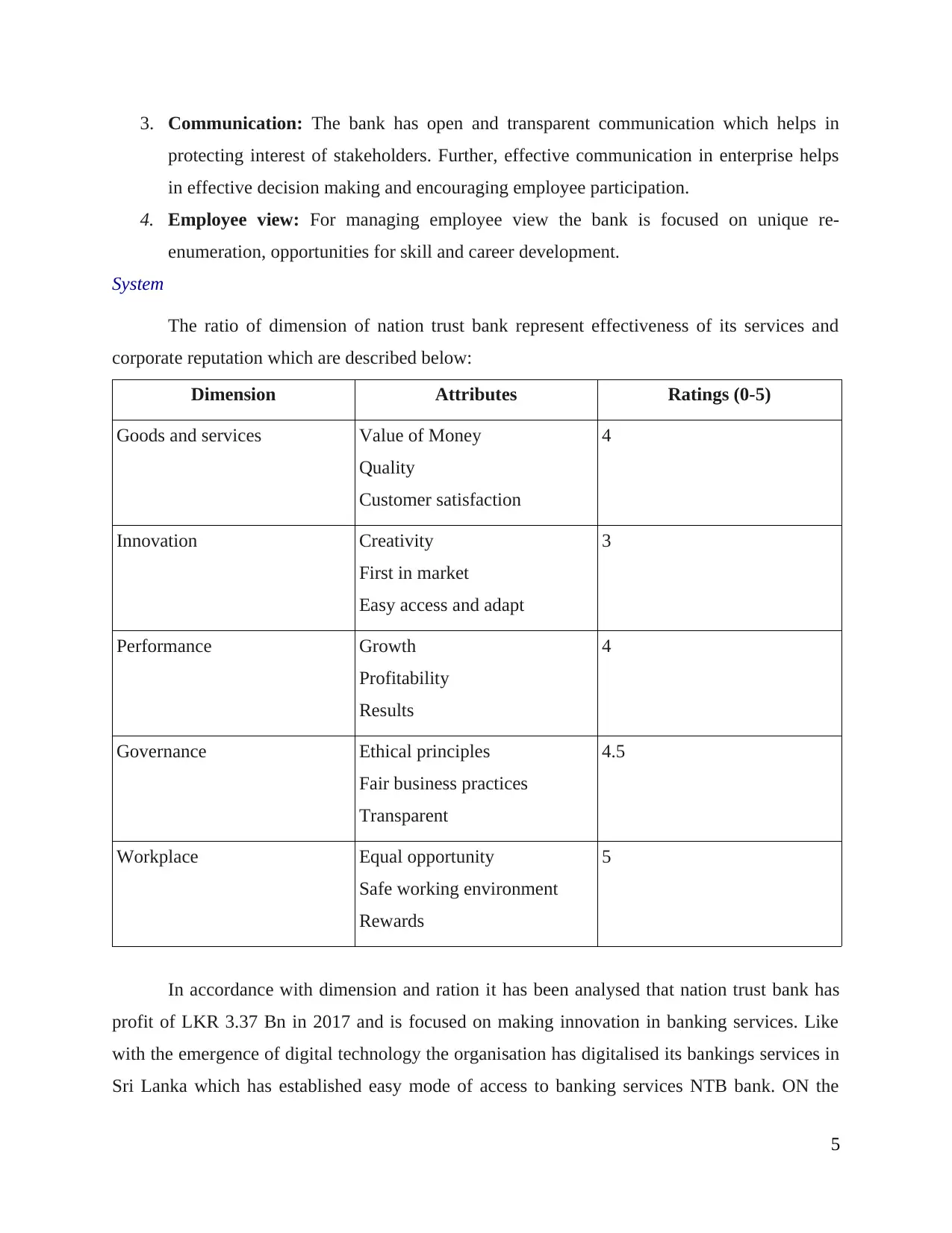
3. Communication: The bank has open and transparent communication which helps in
protecting interest of stakeholders. Further, effective communication in enterprise helps
in effective decision making and encouraging employee participation.
4. Employee view: For managing employee view the bank is focused on unique re-
enumeration, opportunities for skill and career development.
System
The ratio of dimension of nation trust bank represent effectiveness of its services and
corporate reputation which are described below:
Dimension Attributes Ratings (0-5)
Goods and services Value of Money
Quality
Customer satisfaction
4
Innovation Creativity
First in market
Easy access and adapt
3
Performance Growth
Profitability
Results
4
Governance Ethical principles
Fair business practices
Transparent
4.5
Workplace Equal opportunity
Safe working environment
Rewards
5
In accordance with dimension and ration it has been analysed that nation trust bank has
profit of LKR 3.37 Bn in 2017 and is focused on making innovation in banking services. Like
with the emergence of digital technology the organisation has digitalised its bankings services in
Sri Lanka which has established easy mode of access to banking services NTB bank. ON the
5
protecting interest of stakeholders. Further, effective communication in enterprise helps
in effective decision making and encouraging employee participation.
4. Employee view: For managing employee view the bank is focused on unique re-
enumeration, opportunities for skill and career development.
System
The ratio of dimension of nation trust bank represent effectiveness of its services and
corporate reputation which are described below:
Dimension Attributes Ratings (0-5)
Goods and services Value of Money
Quality
Customer satisfaction
4
Innovation Creativity
First in market
Easy access and adapt
3
Performance Growth
Profitability
Results
4
Governance Ethical principles
Fair business practices
Transparent
4.5
Workplace Equal opportunity
Safe working environment
Rewards
5
In accordance with dimension and ration it has been analysed that nation trust bank has
profit of LKR 3.37 Bn in 2017 and is focused on making innovation in banking services. Like
with the emergence of digital technology the organisation has digitalised its bankings services in
Sri Lanka which has established easy mode of access to banking services NTB bank. ON the
5
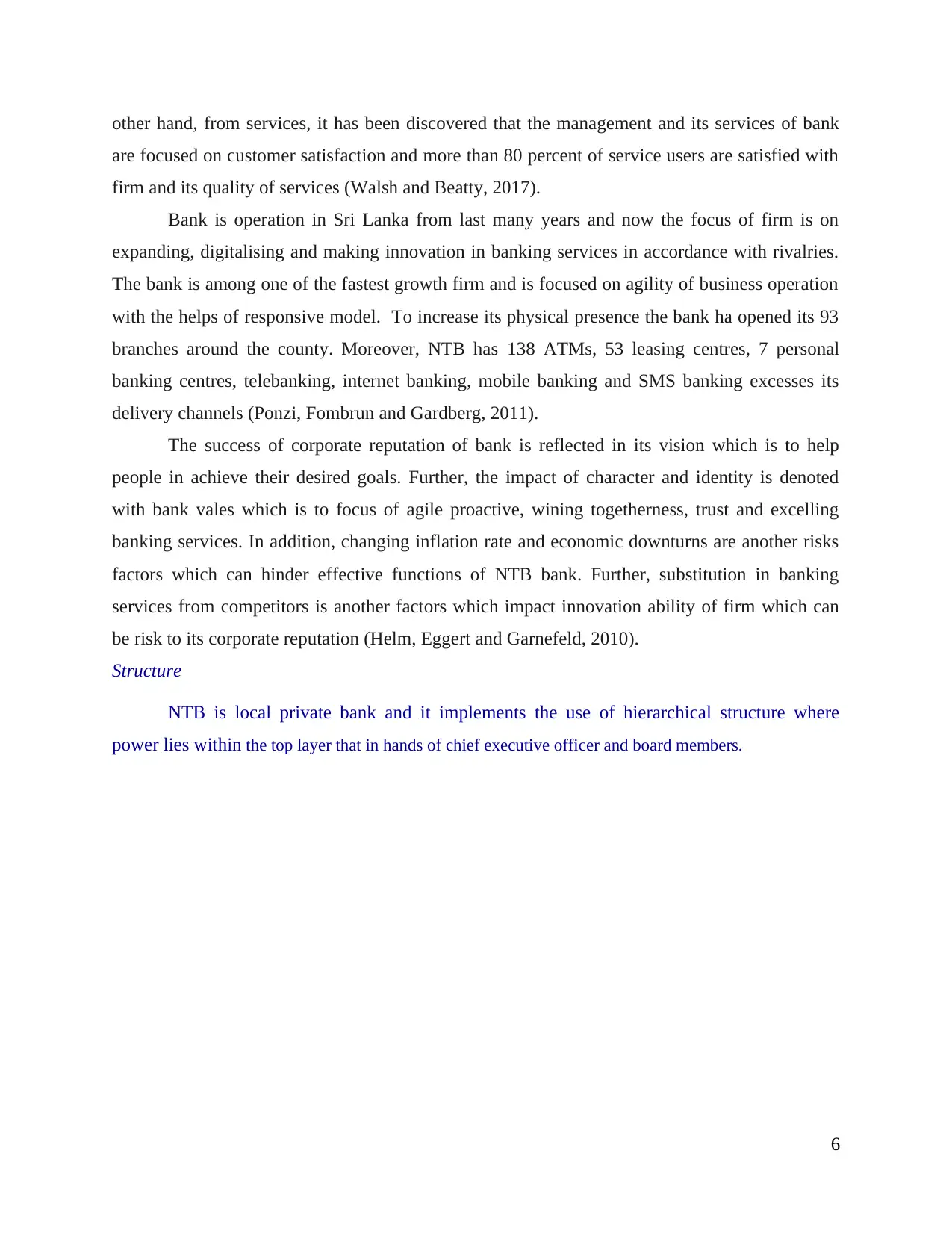
other hand, from services, it has been discovered that the management and its services of bank
are focused on customer satisfaction and more than 80 percent of service users are satisfied with
firm and its quality of services (Walsh and Beatty, 2017).
Bank is operation in Sri Lanka from last many years and now the focus of firm is on
expanding, digitalising and making innovation in banking services in accordance with rivalries.
The bank is among one of the fastest growth firm and is focused on agility of business operation
with the helps of responsive model. To increase its physical presence the bank ha opened its 93
branches around the county. Moreover, NTB has 138 ATMs, 53 leasing centres, 7 personal
banking centres, telebanking, internet banking, mobile banking and SMS banking excesses its
delivery channels (Ponzi, Fombrun and Gardberg, 2011).
The success of corporate reputation of bank is reflected in its vision which is to help
people in achieve their desired goals. Further, the impact of character and identity is denoted
with bank vales which is to focus of agile proactive, wining togetherness, trust and excelling
banking services. In addition, changing inflation rate and economic downturns are another risks
factors which can hinder effective functions of NTB bank. Further, substitution in banking
services from competitors is another factors which impact innovation ability of firm which can
be risk to its corporate reputation (Helm, Eggert and Garnefeld, 2010).
Structure
NTB is local private bank and it implements the use of hierarchical structure where
power lies within the top layer that in hands of chief executive officer and board members.
6
are focused on customer satisfaction and more than 80 percent of service users are satisfied with
firm and its quality of services (Walsh and Beatty, 2017).
Bank is operation in Sri Lanka from last many years and now the focus of firm is on
expanding, digitalising and making innovation in banking services in accordance with rivalries.
The bank is among one of the fastest growth firm and is focused on agility of business operation
with the helps of responsive model. To increase its physical presence the bank ha opened its 93
branches around the county. Moreover, NTB has 138 ATMs, 53 leasing centres, 7 personal
banking centres, telebanking, internet banking, mobile banking and SMS banking excesses its
delivery channels (Ponzi, Fombrun and Gardberg, 2011).
The success of corporate reputation of bank is reflected in its vision which is to help
people in achieve their desired goals. Further, the impact of character and identity is denoted
with bank vales which is to focus of agile proactive, wining togetherness, trust and excelling
banking services. In addition, changing inflation rate and economic downturns are another risks
factors which can hinder effective functions of NTB bank. Further, substitution in banking
services from competitors is another factors which impact innovation ability of firm which can
be risk to its corporate reputation (Helm, Eggert and Garnefeld, 2010).
Structure
NTB is local private bank and it implements the use of hierarchical structure where
power lies within the top layer that in hands of chief executive officer and board members.
6
⊘ This is a preview!⊘
Do you want full access?
Subscribe today to unlock all pages.

Trusted by 1+ million students worldwide
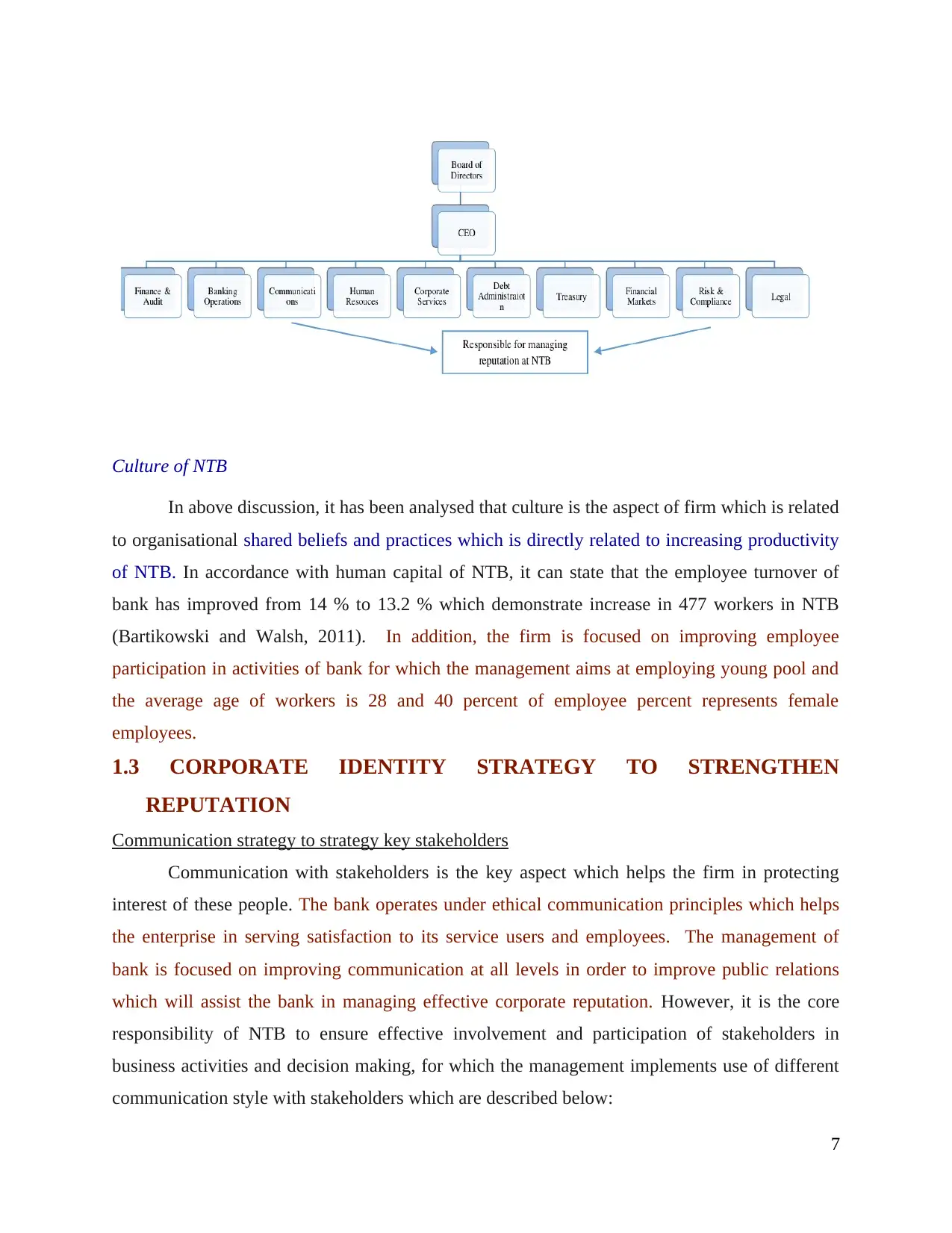
Culture of NTB
In above discussion, it has been analysed that culture is the aspect of firm which is related
to organisational shared beliefs and practices which is directly related to increasing productivity
of NTB. In accordance with human capital of NTB, it can state that the employee turnover of
bank has improved from 14 % to 13.2 % which demonstrate increase in 477 workers in NTB
(Bartikowski and Walsh, 2011). In addition, the firm is focused on improving employee
participation in activities of bank for which the management aims at employing young pool and
the average age of workers is 28 and 40 percent of employee percent represents female
employees.
1.3 CORPORATE IDENTITY STRATEGY TO STRENGTHEN
REPUTATION
Communication strategy to strategy key stakeholders
Communication with stakeholders is the key aspect which helps the firm in protecting
interest of these people. The bank operates under ethical communication principles which helps
the enterprise in serving satisfaction to its service users and employees. The management of
bank is focused on improving communication at all levels in order to improve public relations
which will assist the bank in managing effective corporate reputation. However, it is the core
responsibility of NTB to ensure effective involvement and participation of stakeholders in
business activities and decision making, for which the management implements use of different
communication style with stakeholders which are described below:
7
In above discussion, it has been analysed that culture is the aspect of firm which is related
to organisational shared beliefs and practices which is directly related to increasing productivity
of NTB. In accordance with human capital of NTB, it can state that the employee turnover of
bank has improved from 14 % to 13.2 % which demonstrate increase in 477 workers in NTB
(Bartikowski and Walsh, 2011). In addition, the firm is focused on improving employee
participation in activities of bank for which the management aims at employing young pool and
the average age of workers is 28 and 40 percent of employee percent represents female
employees.
1.3 CORPORATE IDENTITY STRATEGY TO STRENGTHEN
REPUTATION
Communication strategy to strategy key stakeholders
Communication with stakeholders is the key aspect which helps the firm in protecting
interest of these people. The bank operates under ethical communication principles which helps
the enterprise in serving satisfaction to its service users and employees. The management of
bank is focused on improving communication at all levels in order to improve public relations
which will assist the bank in managing effective corporate reputation. However, it is the core
responsibility of NTB to ensure effective involvement and participation of stakeholders in
business activities and decision making, for which the management implements use of different
communication style with stakeholders which are described below:
7
Paraphrase This Document
Need a fresh take? Get an instant paraphrase of this document with our AI Paraphraser
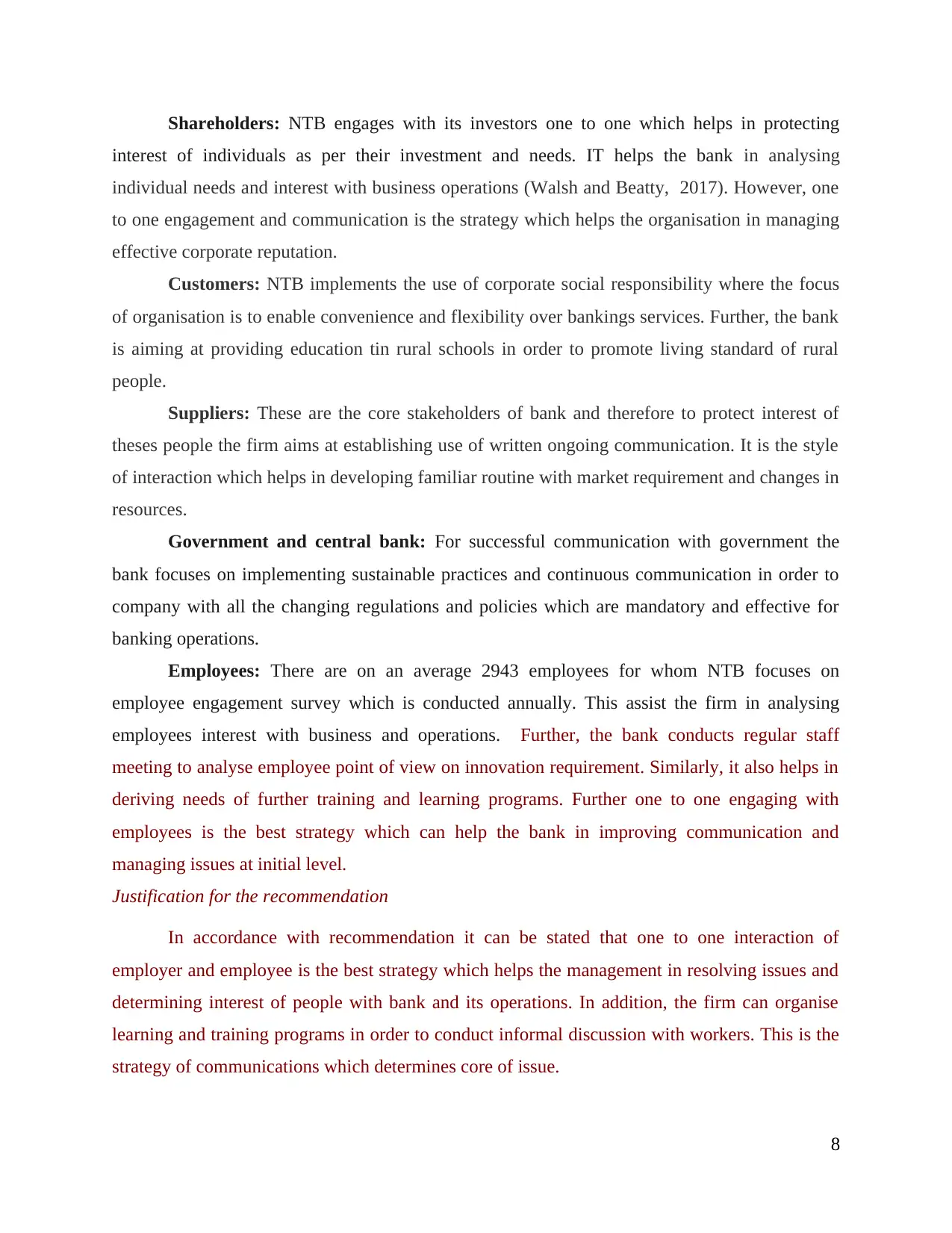
Shareholders: NTB engages with its investors one to one which helps in protecting
interest of individuals as per their investment and needs. IT helps the bank in analysing
individual needs and interest with business operations (Walsh and Beatty, 2017). However, one
to one engagement and communication is the strategy which helps the organisation in managing
effective corporate reputation.
Customers: NTB implements the use of corporate social responsibility where the focus
of organisation is to enable convenience and flexibility over bankings services. Further, the bank
is aiming at providing education tin rural schools in order to promote living standard of rural
people.
Suppliers: These are the core stakeholders of bank and therefore to protect interest of
theses people the firm aims at establishing use of written ongoing communication. It is the style
of interaction which helps in developing familiar routine with market requirement and changes in
resources.
Government and central bank: For successful communication with government the
bank focuses on implementing sustainable practices and continuous communication in order to
company with all the changing regulations and policies which are mandatory and effective for
banking operations.
Employees: There are on an average 2943 employees for whom NTB focuses on
employee engagement survey which is conducted annually. This assist the firm in analysing
employees interest with business and operations. Further, the bank conducts regular staff
meeting to analyse employee point of view on innovation requirement. Similarly, it also helps in
deriving needs of further training and learning programs. Further one to one engaging with
employees is the best strategy which can help the bank in improving communication and
managing issues at initial level.
Justification for the recommendation
In accordance with recommendation it can be stated that one to one interaction of
employer and employee is the best strategy which helps the management in resolving issues and
determining interest of people with bank and its operations. In addition, the firm can organise
learning and training programs in order to conduct informal discussion with workers. This is the
strategy of communications which determines core of issue.
8
interest of individuals as per their investment and needs. IT helps the bank in analysing
individual needs and interest with business operations (Walsh and Beatty, 2017). However, one
to one engagement and communication is the strategy which helps the organisation in managing
effective corporate reputation.
Customers: NTB implements the use of corporate social responsibility where the focus
of organisation is to enable convenience and flexibility over bankings services. Further, the bank
is aiming at providing education tin rural schools in order to promote living standard of rural
people.
Suppliers: These are the core stakeholders of bank and therefore to protect interest of
theses people the firm aims at establishing use of written ongoing communication. It is the style
of interaction which helps in developing familiar routine with market requirement and changes in
resources.
Government and central bank: For successful communication with government the
bank focuses on implementing sustainable practices and continuous communication in order to
company with all the changing regulations and policies which are mandatory and effective for
banking operations.
Employees: There are on an average 2943 employees for whom NTB focuses on
employee engagement survey which is conducted annually. This assist the firm in analysing
employees interest with business and operations. Further, the bank conducts regular staff
meeting to analyse employee point of view on innovation requirement. Similarly, it also helps in
deriving needs of further training and learning programs. Further one to one engaging with
employees is the best strategy which can help the bank in improving communication and
managing issues at initial level.
Justification for the recommendation
In accordance with recommendation it can be stated that one to one interaction of
employer and employee is the best strategy which helps the management in resolving issues and
determining interest of people with bank and its operations. In addition, the firm can organise
learning and training programs in order to conduct informal discussion with workers. This is the
strategy of communications which determines core of issue.
8
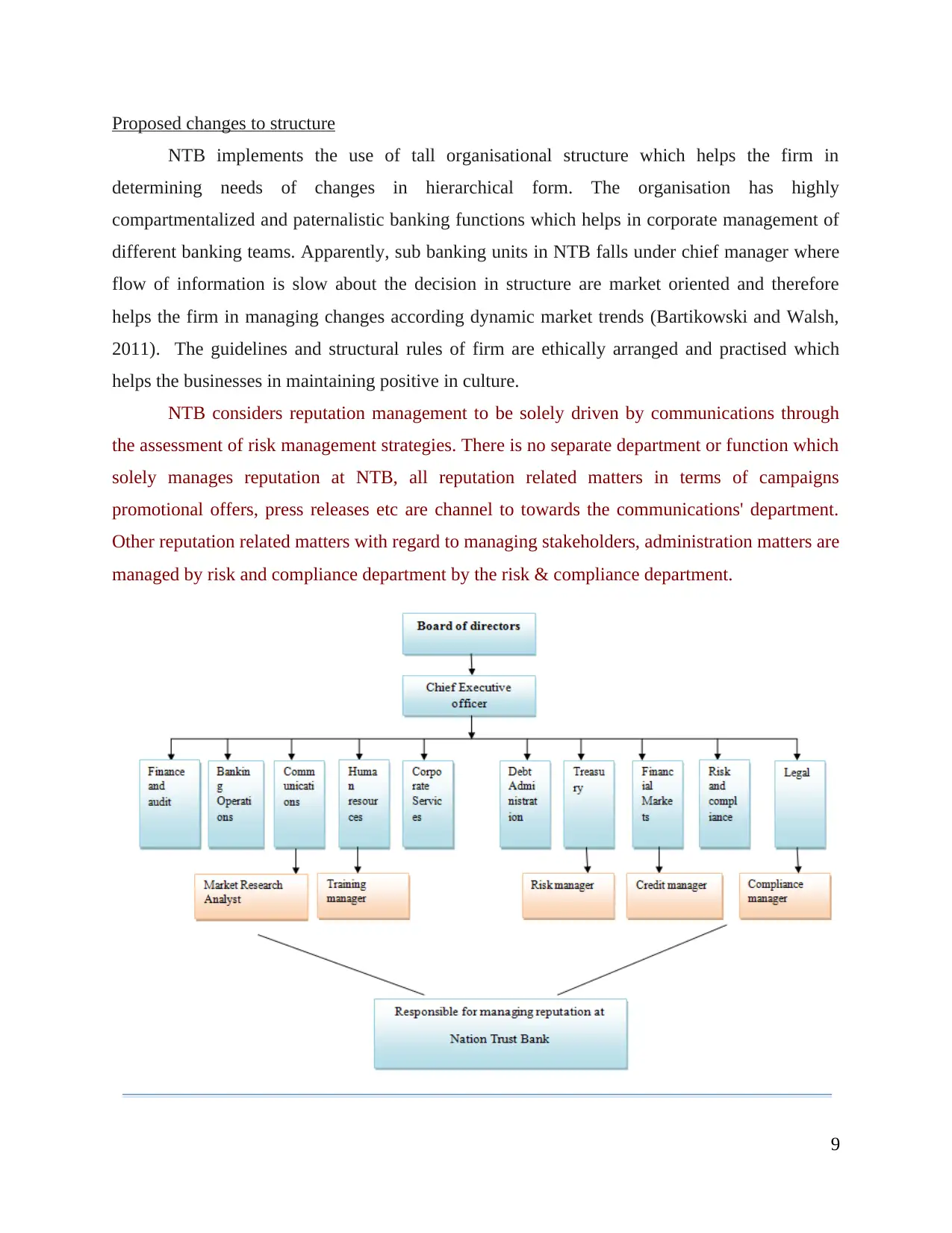
Proposed changes to structure
NTB implements the use of tall organisational structure which helps the firm in
determining needs of changes in hierarchical form. The organisation has highly
compartmentalized and paternalistic banking functions which helps in corporate management of
different banking teams. Apparently, sub banking units in NTB falls under chief manager where
flow of information is slow about the decision in structure are market oriented and therefore
helps the firm in managing changes according dynamic market trends (Bartikowski and Walsh,
2011). The guidelines and structural rules of firm are ethically arranged and practised which
helps the businesses in maintaining positive in culture.
NTB considers reputation management to be solely driven by communications through
the assessment of risk management strategies. There is no separate department or function which
solely manages reputation at NTB, all reputation related matters in terms of campaigns
promotional offers, press releases etc are channel to towards the communications' department.
Other reputation related matters with regard to managing stakeholders, administration matters are
managed by risk and compliance department by the risk & compliance department.
9
NTB implements the use of tall organisational structure which helps the firm in
determining needs of changes in hierarchical form. The organisation has highly
compartmentalized and paternalistic banking functions which helps in corporate management of
different banking teams. Apparently, sub banking units in NTB falls under chief manager where
flow of information is slow about the decision in structure are market oriented and therefore
helps the firm in managing changes according dynamic market trends (Bartikowski and Walsh,
2011). The guidelines and structural rules of firm are ethically arranged and practised which
helps the businesses in maintaining positive in culture.
NTB considers reputation management to be solely driven by communications through
the assessment of risk management strategies. There is no separate department or function which
solely manages reputation at NTB, all reputation related matters in terms of campaigns
promotional offers, press releases etc are channel to towards the communications' department.
Other reputation related matters with regard to managing stakeholders, administration matters are
managed by risk and compliance department by the risk & compliance department.
9
⊘ This is a preview!⊘
Do you want full access?
Subscribe today to unlock all pages.

Trusted by 1+ million students worldwide
1 out of 43
Related Documents
Your All-in-One AI-Powered Toolkit for Academic Success.
+13062052269
info@desklib.com
Available 24*7 on WhatsApp / Email
![[object Object]](/_next/static/media/star-bottom.7253800d.svg)
Unlock your academic potential
Copyright © 2020–2025 A2Z Services. All Rights Reserved. Developed and managed by ZUCOL.





